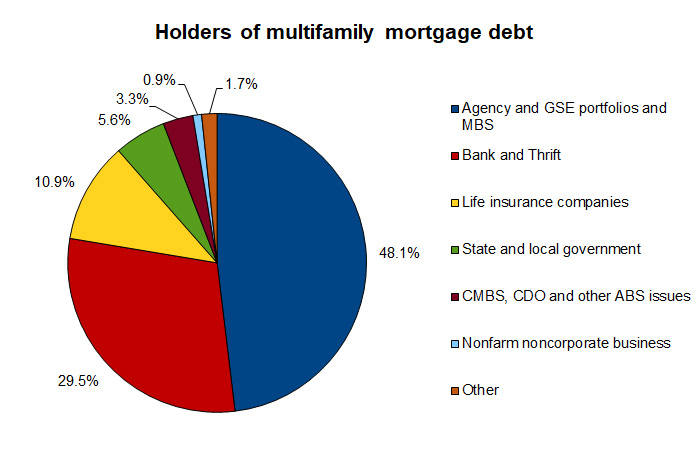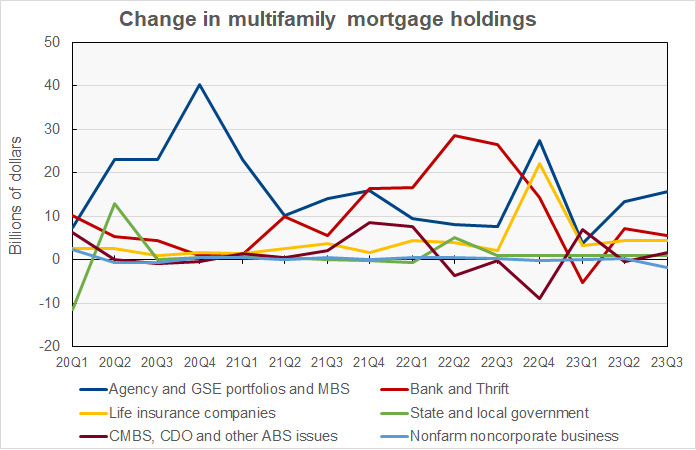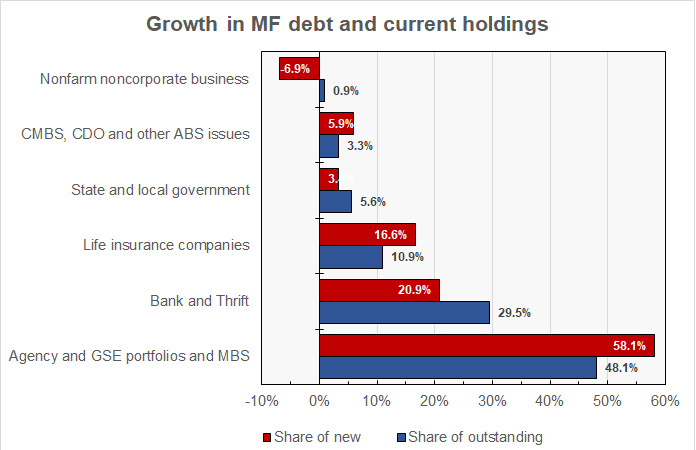A Mortgage Bankers Association (MBA) report shows that growth in multifamily mortgage debt outstanding in Q3 2023 was up from that in Q2. Growth in multifamily mortgage holdings was down from the Q3 2022 level but it was in line with that of Q3 2021.
The MBA reported that multifamily mortgage debt outstanding rose by $26.8 billion in Q3, slightly higher than the $23.0 billion increase in Q2. Total multifamily mortgage debt reached a level of $2.051 trillion. Compared to the year-earlier level, multifamily mortgage debt was up $124.9 billion (6.5 percent).
The total of all commercial mortgage debt, including multifamily debt, outstanding at the end of Q3 rose 0.8 percent from its Q2 2023 level to $4.634 trillion. Multifamily mortgages represented 44.3 percent of commercial mortgage debt outstanding.
Earlier, the MBA had reported that multifamily mortgage originations had fallen 16 percent in Q3. In addition, the Q3 2023 multifamily mortgage originations index was reported to be down 50 percent from its level in Q3 2022.
Ranking the lenders
The shares of multifamily mortgage debt held by various classes of suppliers are shown in the first chart, below.

Of the increase in multifamily mortgage debt outstanding in the quarter, $15.6 billion, or 58.1 percent, was held by “Agency and GSE portfolios and MBS”. These are agencies, like the Federal Housing Administration and Government Sponsored Enterprises (GSEs) like Fannie Mae and Freddie Mac, who buy up mortgages and sell some of the debt as Mortgage-Backed Securities (MBS). At the end of Q3, the GSEs holdings of multifamily mortgage debt rose to 48.1 percent of the total outstanding, up 0.1 percentage point in the quarter.
Banks and Thrifts, the second largest holders of multifamily mortgages, increased their multifamily mortgage holdings by $5.6 billion, the second quarter of positive growth after their holdings fell in Q1. The Q3 figure represented 20.9 percent of the increase in multifamily mortgage debt outstanding, well below their holdings of 29.7 percent of total multifamily debt outstanding.
Life Insurance companies increased their direct holding of multifamily mortgage debt by $4.5 billion in the quarter, 16.6 percent of the total net increase. This raised their holdings to $223.4 billion. Their share of total multifamily mortgage debt outstanding rose 0.1 percentage point to 10.9 percent in the quarter. However, this figure does not account for the multifamily mortgages these companies hold through commercial mortgage-backed securities (CMBS).
State and local governments held 5.6 percent of outstanding multifamily mortgage debt at the end of Q3. They increased their holdings by $901 million to a total of $115.0 billion at the end of the quarter.
CMBS, CDO (collateralized debt obligations) and other ABS (asset backed securities) issuers increased their holdings of multifamily mortgage debt in Q3 by $1.58 billion. They had reduced their net holdings in Q2. Their share of multifamily mortgages outstanding rose 0.1 percentage points to 3.3 percent.
The next chart, below, shows the quarterly changes in multifamily mortgage holdings of the 6 largest classes of lenders since Q1 2020. It is hard to observe a pattern in the data in this chart as conditions were not “normal” at any point in the timeframe illustrated. COVID arrive in Q2 2020 resulting in most lenders, except the GSEs, nearly halting their businesses. Inflation surged in Q2 2021 followed soon by surging rents. This led to high transaction volumes in late 2021 into mid-2022. The collapse of several banks, notably Silicon Valley Bank, in Q1 2023 again roiled markets. The latest quarterly results show GSE’s and life insurance companies continuing to lend while banks cut back.

Changes in shares
The next chart, below, plots the current share of multifamily mortgage debt outstanding for a given class of lender alongside that class of lender’s share of net new mortgage debt outstanding in Q3. When the latter share is greater than the former, that class of lender is increasing its share of the multifamily mortgage market.

The chart shows that the GSEs again provided the bulk of the increase in multifamily mortgage lending during the quarter. Banks and thrifts remained the second leading contributor to the mortgage debt increase, although their share was well below their current share of debt outstanding. Life insurance companies increased their share of multifamily mortgage debt outstanding, as they have now done for the last 4 quarters. State and local governments decreased their share of outstanding debt while the highly volatile CMBS segment increased theirs.
A consideration when looking at the debt-share numbers is that several classes of lenders, including nonfarm noncorporate businesses, the federal government, REITs, finance companies and state and local government retirement plans, all reduced their mortgage holdings during the quarter. The amount of the reduction is such that the growth in holdings of those lenders who increased their holdings came to 109 percent of the net change in holdings during the quarter.
The report does not cover loans for acquisition, development or construction, or loans collateralized by owner-occupied commercial properties. The full report also includes information on mortgage debt outstanding for other commercial property types. The full report can be found here.















